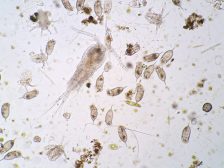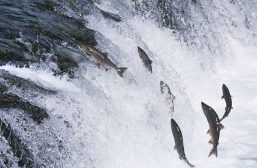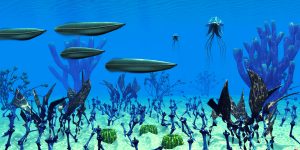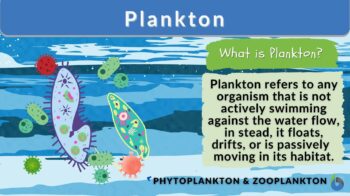
Plankton
n., plural: plankton or planktons
[ˈplæŋk.tən]
Definition: organisms that drift, float, or move passively in their aquatic habitat
Table of Contents
Plankton is a diverse group of typically microscopic, aquatic organisms suspended in the water column and rely on water currents to move. They are unable to actively swim against the water flow due to their size and lack of locomotion. While some plankton spend their entire life drifting passively, others are only considered plankton during their early developmental stages.
We all have come across some or the other water bodies overloaded with green plant sort of layer to an extent that the water body itself begins to die off. The over-accumulation of minerals, nutrients, run-off fertilizers, sewage, and industrial outlets often pushes the water bodies to the edge. This unwarranted abuse of water bodies leads to the build-up of a type of plankton called “phytoplankton/ microscopic plants”.
In the present times where industrialization and commercialization are unabatedly driving society, a conscious approach to look after our natural resources, specifically water bodies (oceans, seas, estuaries, rivers, lakes, and ponds) has taken a backseat.
Here, we will explain what are planktons and to which category phytoplanktons belong. We will also shed light on the other types of planktons, and their classification systems and talk in length about their ecological significance.
In contrast to the notion that phytoplanktons are the only type of plankton, we’ll unravel how many more varieties exist on Earth. Read on to learn why planktons constitute an irreplaceable position in ecological systems.
What is Plankton?
Conventionally, the term plankton is used to define a diverse group of typically microscopic, aquatic organisms that are suspended in the water column and rely on oceanic or other water body currents to move. They are unable to actively swim against the water flow due to their size and lack of locomotion.
There is a general misconception that the algal accumulation of lakes and ponds, in form of a green sheet/layer is solely called plankton, but that is not true. Planktons are represented by a diverse group of organisms like algae (tiny creatures or tiny plants), bacteria, protozoans, archaea, and small drifting animals. They constitute both marine and freshwater plankton.
Included as well is a brief description of the aeroplanktons. While the planktons have always been believed to live in water bodies, scientific reports have evidenced their presence in the air too. (Ref.1,2,3) Read on till the end to learn the fascinating biology of aeroplanktons!!!
Etymology or Terminology
Plankton is a 19th-century German word. It is derived from the Greek word “plankton” meaning ‘wandering’ which has been further derived from an older Greek word “plazein” meaning ‘to wander or drive astray’.
The term was coined by Victor Hansen, a German marine biologist. Hansen first used the word plankton for describing life forms that thrive in water bodies particularly the sea in a suspended form. He also emphasized the importance of plankton as all aquatic life practically depends (either directly or indirectly) on plankton.
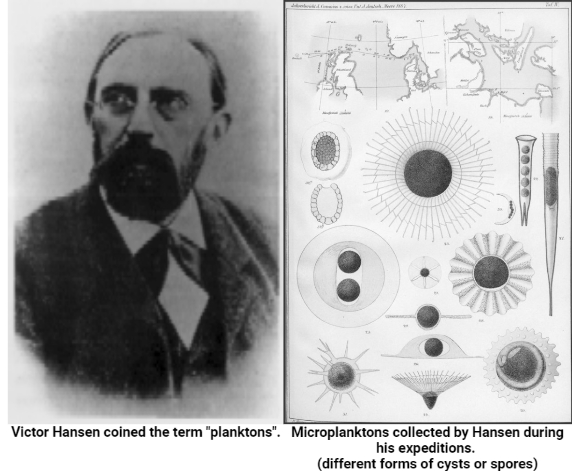
Watch this vid about plankton:
Plankton refers to organisms floating, drifting, or weakly swimming in bodies of water. Examples are planktonic algae, bacteria, archaea, protozoa, etc. Some of them may be capable of vertical migration but they, in general, flow with their surrounding currents. (Organisms that are capable of swimming against the current are called nekton).
Trophic Groups
Planktons form the basis of aquatic food pyramids, whether it is freshwater or seawater. The role that planktons serve in marine ecosystems is phenomenal. They are the biological entities over which the entire marine food web rests. Planktonic forms can be categorized into groups for the ease of studying them.

First Trophic Level and Phytoplanktons
Phytoplanktons usually form the first level of plankton in this web. They can convert the energy of photons (light energy) to food (chemical energy) via phytoplankton photosynthesis.
Phytoplanktons possess the unique pigment molecule “chlorophyll” which plants possess for harvesting sunlight.
By photosynthesis, planktons fix the atmospheric carbon dioxide into organic carbon. Phytoplankton produces their food.
NOTE IT!
Interesting Facts on Planktons
FACT-1: Of the total global plant carbon, phytoplanktons possess only 1-2% of their biomass. (Ref.4)
FACT-2: Even with such a small biomass (limited presence), phytoplanktons annually fix nearly 30,000,000,000-50,000,000,000 metric tons of carbon. This capability to fix humongous amounts of atmospheric carbon makes phytoplanktons phenomenal creatures; the ocean’s green machines! This usually accounts for 40% of the world’s total carbon that needs to be fixed by plants. (Ref.4) No doubt, phytoplanktons back their terrestrial green friends (trees and plants) a lot! 😀

FACT-3: NOAA (National Oceanic and Atmospheric Administration) Ocean Exploration of the U.S. Department of Commerce reports that phytoplanktons produce more than half of the atmospheric oxygen. In rough figures, it is nearly 50-70% of the atmospheric oxygen. No doubt, these organisms evolved quite early on the face of Earth (much earlier than land plants). As we all know that Earth’s atmosphere right now consists of 21% molecular oxygen (O2) but this wasn’t always the case. The contributions of phytoplanktons in enriching the Earth’s atmosphere with O2 gas (and increasing it from a minimal 5%; 600 million years ago) and ensuring the movement of life from water to land are spectacular. No wonder, we should thank phytoplanktons with every breath we take!!! (Ref.5)

Since their nature resembles that of plants, they are appropriately described as “phytoplanktons” where phyto– stands for ‘plants’.
Phytoplanktons serve as food for small animals and zooplanktons in the aquatic systems. Subsequently, zooplanktons serve as food for fish, lobsters, barnacles, prawns, crabs, and other larger animals.
Nature: Autotrophic mode of nutrition
Form of life: Prokaryotic and eukaryotic algae
Zone of water body occupied: Usually the top layer or water surface (to capture sufficient light for carrying out photosynthesis)
Examples:
» Diatoms (cell walls of silica)
» Cyanobacteria
» Dinoflagellates
» Coccolithophores
Zooplanktons
There is another commonly known form of planktons called “zooplanktons”. In contrast to the autotrophic phytoplanktons, zooplanktons are heterotrophic. They depend on the former for their dietary requirements and nutrition.
Nature: Heterotrophic mode of nutrition
Form of life: Small protozoans or metazoans
Examples:
» Zooflagellates
» Foraminiferans
» Radiolarians
» Some dinoflagellates
» Marine micro animals
To learn more about autotrophic and heterotrophic modes of nutrition, you can refer to our comprehensive lessons on Autotroph and Heterotroph.

Mixoplanktons
Mixoplanktons adopt the mixed trophic strategy called mixotrophy.
They can act as both consumers as well as producers. This switch between the roles can happen at any point in time when the organism senses the ambient conditions. The organism can also act as both producer and consumer at the same time.
Pros:
» Enables the organism to photosynthesize when nutrients and light resources are abundant.
» Enables to switch to the heterotrophic mode of nutrition when ambient light conditions are not suitable.
Groups: Studied under two groups namely “constitutive mixotrophs (CM)” and “non-constitutive mixotrophs (NCM)”. CMs can photosynthesize on their own while NCMs rely on the phagocytosis process for the engulfment of phototrophic prey.
There are 2 fates of the prey in NCMs.
FATE-1: The prey is kept alive in the bodies of the host and helps the host in deriving benefits from the photosynthesis outputs of prey residing in the host body.
FATE-2: The prey is digested except their plastids which now become a part of the host’s body and aid photosynthesis. This phenomenon of internalizing the prey’s plastids is called “kleptoplasty”.
Mixotrophy is an exceptional occurrence in nature and more research efforts will bring out more phenomenal processes for human wondering and understanding.
Importance:
» Role in marine biogeochemistry.
» Mixotrophs constitute more than 1/2 of all microscopic plankton on the Earth.
» Act as buffers and help in the prevention of the collapse of ecosystems in times of minimal to no light.
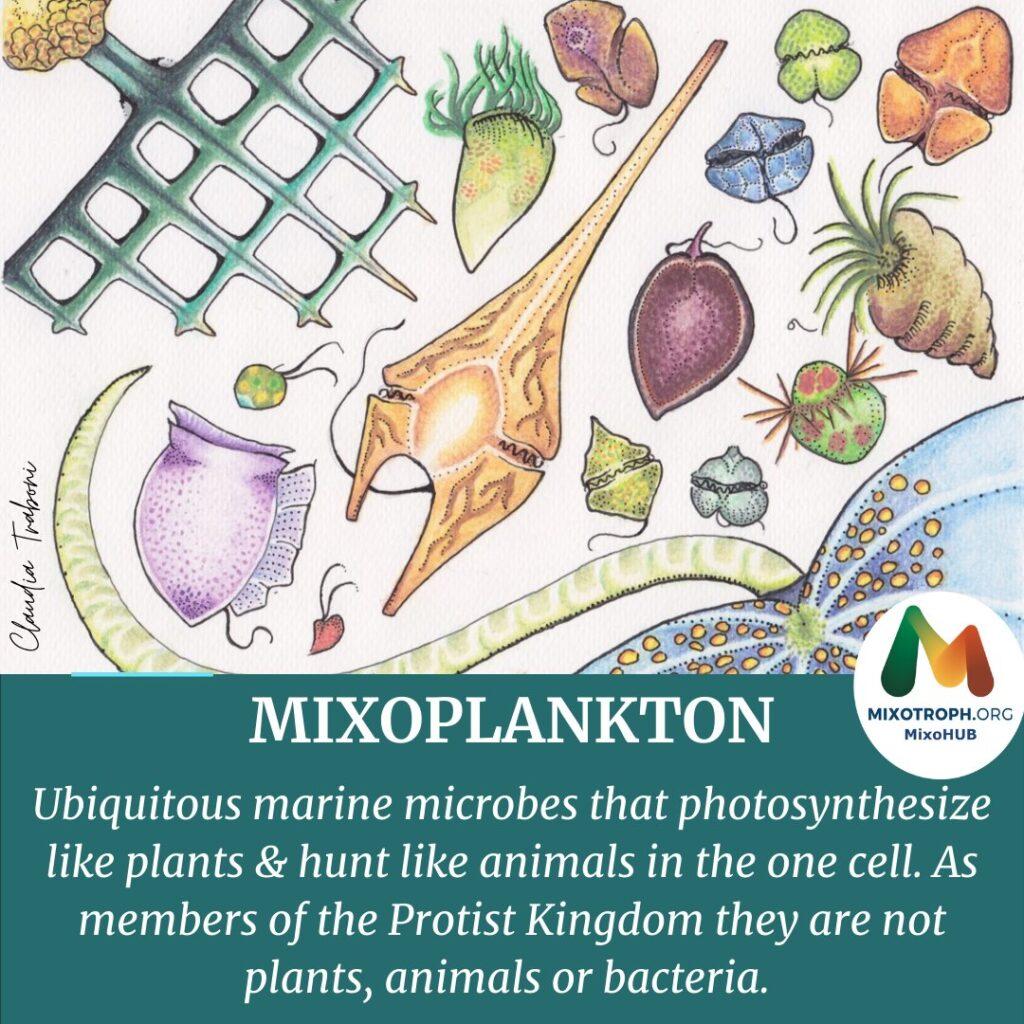
Size Groups
Based on the sizes, planktonic forms are studied under the following headings. (increasing order)
Morphological details of individual organisms of macroplanktons are easily discernible due to their large sizes while the same is not possible with the naked eyes for femtoplanktons and other microscopic planktonic forms.
Table 1: Different groups of planktons based on their sizes | ||
|---|---|---|
| Group | Size (Equivalent spherical diameter) | Examples with references (for further reading) |
| Femtoplankton | < 0.2 µm | Marine viruses (Ref.7) |
| Picoplankton | 0.2-2 µm | Small eukaryotic protists, Chrysophyta (Ref.8) |
| Nanoplankton | 2-20 µm | Chrysophyta, Chlorophyta (Ref.9) |
| Microplankton | 20-200 µm | Gambierdiscus toxicus (Ref.10) |
| Mesoplankton | 0.2-20 mm | Copepoda, Cladocera, Tunicata (Ref.11) |
| Macroplankton | 2-20 cm | Euphausiid, pteropod, siphonophores (Ref.12) |
| Megaplankton | > 20 cm | Cnidarians (Ref.3) |
Data Source: Akanksha Saxena of Biology Online
Habitat Groups
Based on the habitat majorly occupied by the planktonic forms, planktons are categorized as the underlisted ones.
Marine plankton
Marine planktons are a diverse group of organisms that float freely in the ocean’s water column, serving as the base of the aquatic food chain.
They can be classified into two main categories: phytoplankton and zooplankton. The ocean currents that circulate near the coasts play a crucial role in plankton production and distribution in a particular region.
Interesting fact: Marine planktons are responsible for producing more than half of the world’s oxygen supply through photosynthesis. Despite their small size, they are vital to the functioning of the global ecosystem, providing the foundation for the marine food chain and playing a critical role in regulating the Earth’s climate.
Other roles: In addition to their ecological importance, marine plankton has also played a significant role in scientific research. For example, studies of phytoplankton can provide valuable information about the effects of climate change on ocean productivity and carbon cycling, while research on zooplankton can shed light on the impacts of fishing and other human activities on marine ecosystems.

Freshwater plankton
Freshwater planktons are a diverse group of organisms that inhabit freshwater ecosystems, including lakes, ponds, and rivers. Like marine plankton, they play a vital role in the aquatic food web, serving as the primary producers at the base of the food chain and providing food for a variety of larger organisms.
Interesting fact: Freshwater planktons are responsible for the production of nearly a quarter of the world’s primary productivity. (You can read more about primary productivity and net primary productivity here.) This is a remarkable feat considering that freshwater ecosystems make up only a small fraction of the Earth’s surface area.
In addition to their importance as primary producers, freshwater plankton also play a critical role in nutrient cycling, water quality regulation, and the maintenance of biodiversity.
They can be classified into two main categories: phytoplankton and zooplankton.
Freshwater plankton have also played a significant role in human culture and industry. For example, certain species of phytoplankton, such as Spirulina, are cultivated for their high protein content and use in food products; others have been used for centuries in traditional medicine.

Aeroplankton
Jump to the Factoid section: The Magic called “Aeroplanktons”
Geoplankton
Geoplanktons are a diverse group of microorganisms that live in the Earth’s subsurface, including soils, sediments, and groundwater.
Unlike other types of plankton, geoplanktons are not free-floating in water, but rather are found in the pores and spaces between soil particles and rocks. They survive in the microscopic presence of water or moisture.
Interesting fact: Geoplanktons are capable of surviving in some of the most extreme environments on Earth, including hot springs, deep sea sediments, and even inside solid rock. Given the extreme range of temperature, these microorganisms have evolved a variety of adaptations that allow them to thrive in these challenging conditions, such as the ability to survive high temperatures, low oxygen levels, and high pressure.
Classification: Geoplanktons can be classified into several different groups, including bacteria, archaea, fungi, and protozoa. They play a crucial role in nutrient cycling and decomposition in soil and sediment environments, breaking down organic matter and releasing nutrients that are essential for plant growth.
In addition to their ecological importance, geoplanktons have also been the focus of scientific research due to their potential applications in bioremediation and biotechnology. For example, certain species of geoplanktons have been found to have the ability to break down pollutants in contaminated soils and groundwater, while others have been used to produce enzymes and other bioproducts for industrial purposes.
Other Groups
There are some more groups of planktonic forms of life as listed and described below.
Gelatinous zooplankton
Gelatinous zooplanktons are a group of planktonic organisms that are characterized by their gelatinous, transparent bodies.
They are found throughout the world’s oceans and are composed of a wide variety of species, including jellyfish, comb jellies, and salps.
Interesting fact: They play an important role in ocean ecosystems. While they are not typically thought of as primary predators, they are actually quite effective at capturing and consuming other small organisms such as fish larvae and small crustaceans.
Some species of gelatinous zooplankton are known to form large swarms or blooms, which can have a significant impact on the food web and nutrient cycling in the ocean.
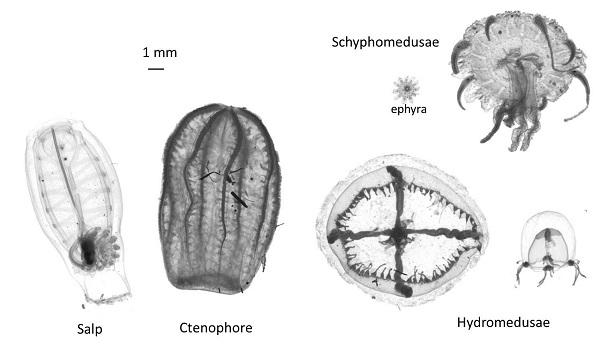
Ichthyoplankton
Ichthyoplanktons refer to the eggs and larvae of fish, which float and drift in the open waters of rivers, oceans, and other water bodies.
Interesting fact: They have a vital role in the survival of many fish species. They help colonize new areas by drifting with ocean currents and forming new populations. Additionally, they serve as an essential food source for various marine organisms, including larger fish and birds.
This necessitates the comprehensive study of the behavior and distribution of ichthyoplankton for the conservation and management of marine ecosystems, and the preservation of fish populations that depend on them.

Holoplankton
Holoplanktons are a type of plankton that exists as planktonic organisms throughout their entire life cycle, from the egg to the adult stage. Their entire lives are planktonic.
Interesting fact: They play a critical role in aquatic food webs. Holoplanktons are consumed by a wide variety of marine organisms, ranging from small invertebrates to large fish and marine mammals. As such, they are an essential link in the transfer of energy through the food chain.
Holoplanktons are a diverse group of organisms, including copepods, krill, and jellyfish.
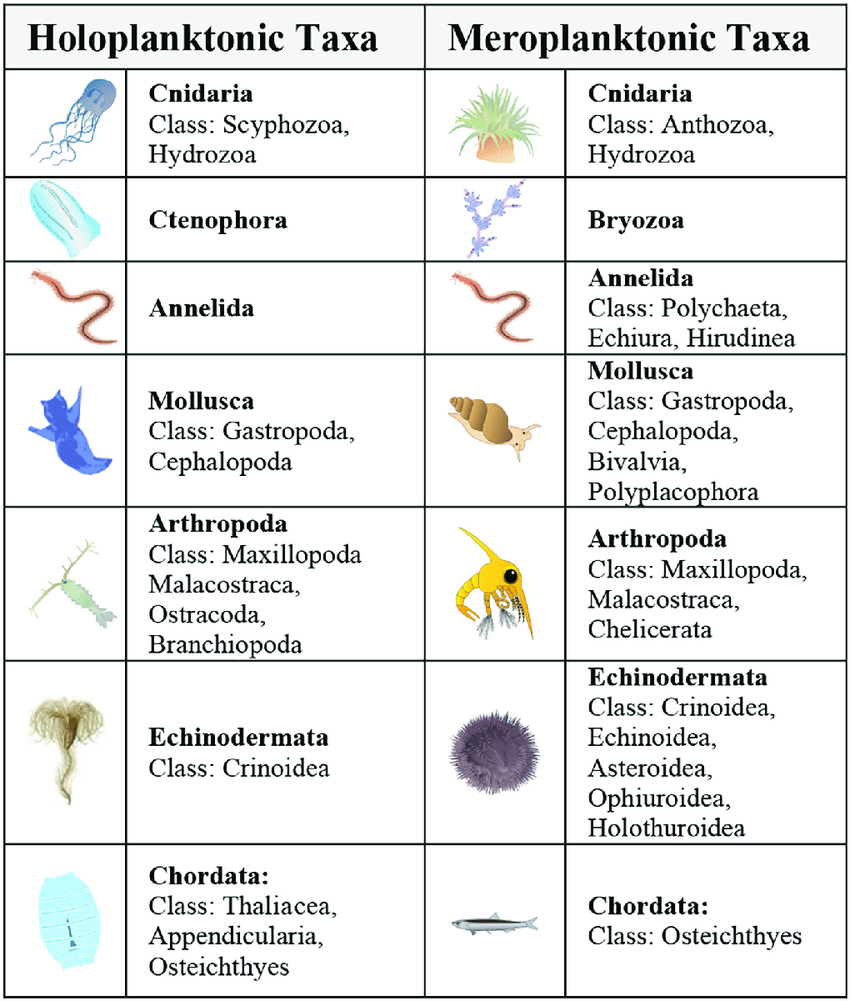
Meroplankton
Meroplanktons are a type of plankton that spend only part of their life cycle as planktonic organisms.
Interesting fact: They include the larvae of many familiar marine organisms, such as crab larvae, lobsters, and oysters. These larvae are usually free-swimming and planktonic for a period of time before they settle on the seafloor and metamorphose into their adult forms.
Role: They play a significant role in the distribution and dispersal of many marine organisms, contributing to the genetic diversity of populations and maintaining healthy ecosystems.
Pseudoplankton
Pseudoplanktons are organisms that are not true plankton, but are often found associated with planktonic communities.
Interesting fact: They include a wide variety of organisms, such as larval fish, crab megalopae, and sea snail veligers.
The presence of pseudoplankton in planktonic communities can significantly impact the ecology of marine environments, as they contribute to the transfer of energy and nutrients within the food web.
Tychoplankton
Tychoplanktons are a type of planktonic organisms that are associated with temporary or ephemeral aquatic habitats, such as vernal pools or temporary ponds.
Interesting fact: They have adapted to survive in highly variable and unpredictable environments, where the availability of nutrients and other resources can fluctuate rapidly.
Tychoplankton communities are highly diverse, and include a wide variety of organisms, such as rotifers, cladocerans, and copepods.
Importance: Their study is important for understanding the dynamics of temporary aquatic ecosystems and for the conservation of species that depend on them.
Mineralized plankton
Mineralized planktons are a type of planktonic organisms that play a significant role in the global carbon cycle.
Interesting fact: They are composed of calcium carbonate or opal, which allows them to form hard structures that sink to the ocean floor when they die. These structures, known as “marine snow”, are important in sequestering carbon from the atmosphere and transferring it to the deep ocean.
Mineralized plankton include organisms such as foraminifera, coccolithophores, and radiolarians, and are studied to better understand the biogeochemistry of marine ecosystems and their impact on climate change.
Distribution
Plankton can be found in oceans, seas, lakes, and ponds, and their abundance varies with location, depth, and season. The availability of light is the primary factor that determines the variability of plankton ecosystems. Plankton ecosystems are primarily fueled by solar energy input, except for some ecosystems that rely on chemosynthesis.
Nutrient availability is a secondary factor, and large areas of the tropical and subtropical oceans have abundant light but limited nutrients. Micronutrient iron deficiency in unproductive ocean regions can be alleviated by the deposition of dust on the sea surface. Plankton can be found throughout the water column, and zooplankton and bacterioplankton consume sinking organic material from more productive surface waters. The distribution of plankton can also be affected by wind-driven Langmuir circulation.
Ecological Significance
Let’s look briefly at the ecological significance of planktons.
Food chain
Plankton plays a vital role in aquatic food chains, food webs, and trophic pyramids.
They form the base of the aquatic food chain by being the primary producers, producing food through photosynthesis or chemosynthesis.
They are consumed by primary consumers, such as small fish and zooplankton, which are in turn eaten by secondary consumers, such as larger fish, crustaceans, and squid. These secondary consumers can then be eaten by tertiary consumers, such as sharks and marine mammals.
The amount of energy transferred between each level of the food chain is known as trophic levels, and the base of the pyramid is always made up of primary producers, such as plankton.
The health and abundance of plankton populations are crucial for the survival of many species in aquatic ecosystems.
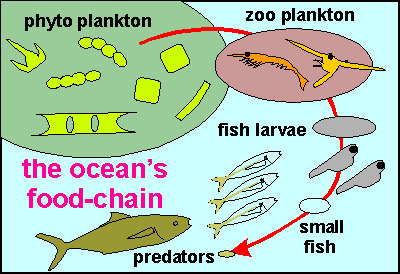
Carbon cycle
Plankton plays a vital role in the Earth’s carbon cycle, which involves the circulation of carbon between the atmosphere, ocean, and land.
Phytoplanktons, which are microscopic plant-like organisms, are responsible for approximately half of the Earth’s primary production, using photosynthesis to convert carbon dioxide into organic matter.
This organic matter is then consumed by zooplankton and other organisms, which are in turn eaten by larger predators.
When these organisms die, their remains sink to the ocean floor, effectively sequestering carbon in the deep ocean for thousands of years.
The role of plankton in the carbon cycle has significant implications for climate change, as changes in their abundance and distribution can affect the amount of carbon dioxide in the atmosphere.
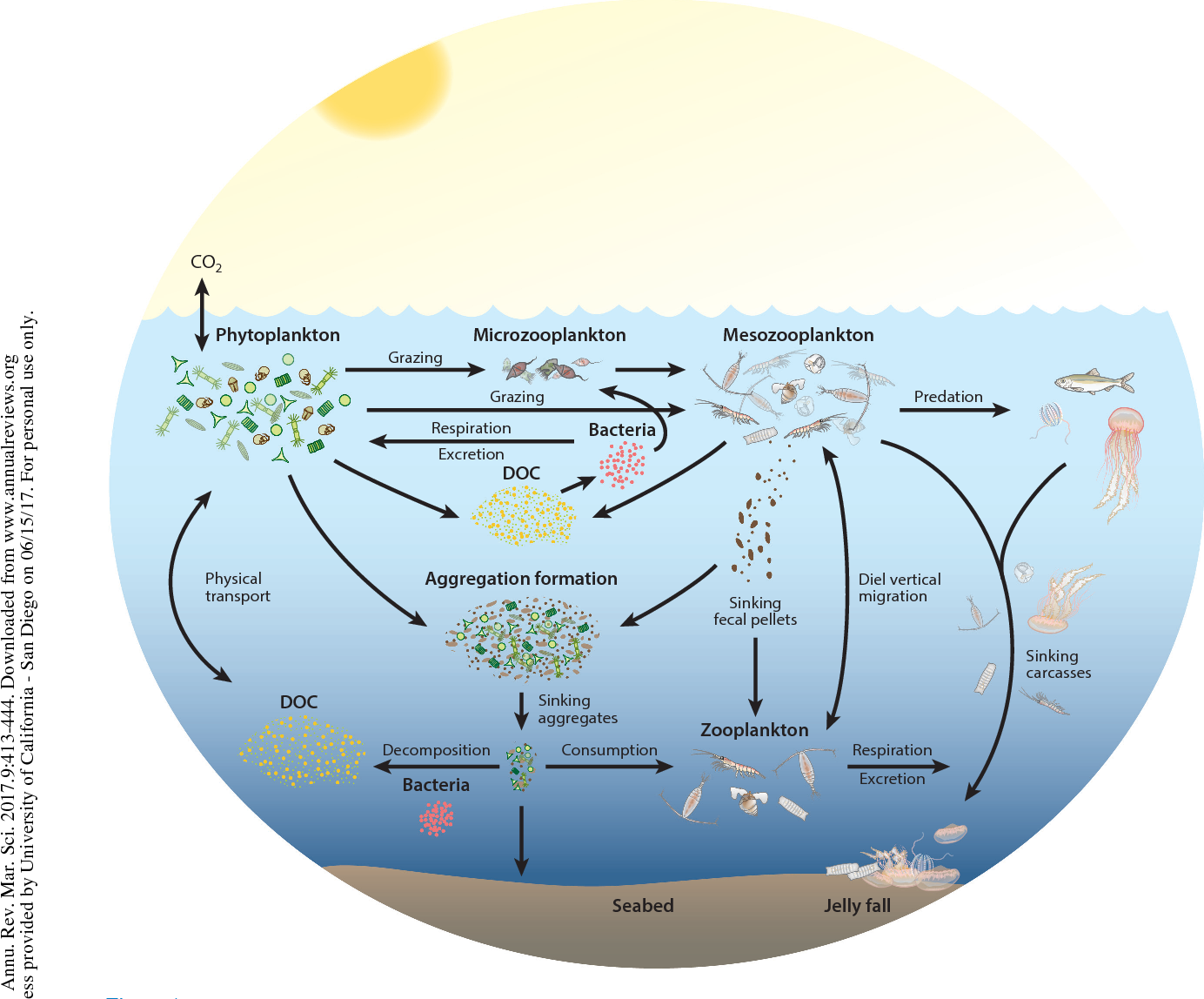
Oxygen production
Plankton also plays a crucial role in the production of oxygen in the Earth’s atmosphere.
Phytoplanktons, in particular, are responsible for approximately more than half of the global oxygen production.
Through the process called photosynthesis, they take in carbon dioxide and release oxygen, contributing significantly to the oxygen content of the atmosphere.
Additionally, zooplanktons and bacterioplankton play a role in the production of oxygen by breaking down and recycling organic matter that has sunk to deeper depths.
This helps to maintain the oxygen balance in the ocean and ultimately affects the entire planet’s atmosphere.
Without plankton, the oxygen content of our planet’s atmosphere would be severely impacted, with significant consequences for life on Earth.

Absorption efficiency
Absorption Efficiency (AE) refers to the efficiency with which plankton are able to absorb and utilize nutrients from their environment.
Different species of plankton have varying AE values depending on their morphology, physiology, and the surrounding environmental conditions.
High AE values enable plankton to better compete for limited resources and increase their growth rates. Low AE values may indicate adaptation to low-nutrient environments or reliance on alternate nutrient sources.
Understanding AE is important for predicting the response of plankton communities to changing environmental conditions, including nutrient availability, temperature, and ocean acidification.
Biomass Variability
The growth of phytoplankton is a critical aspect of oceanic biogeochemical cycling and the marine food web. However, the rate of phytoplankton growth is “limited” by a combination of light availability and nutrient availability.
Different regions of the world’s oceans experience varying degrees of limitation by these factors. For instance, phytoplankton growth in the oligotrophic tropical and subtropical gyres is typically constrained by nutrient supply, whereas subarctic gyres are limited by light availability. This variability in phytoplankton growth has significant implications for higher trophic levels since these organisms form the base of the marine food web.
Furthermore, anthropogenic warming is expected to have significant effects on global phytoplankton populations.
Example: Changes in the vertical stratification of the water column and temperature-dependent biological reactions, as well as alterations in the atmospheric supply of nutrients, may impact future phytoplankton productivity. These changes may also affect the rate of phytoplankton mortality due to zooplankton grazing.
Plankton Diversity
Plankton diversity encompasses a wide range of organisms, including bacteria, archaea, algae, protozoa, and animals. Some examples of plankton include diatoms, dinoflagellates, copepods, krill, and jellyfish. These organisms vary greatly in size, shape, and function, from tiny unicellular diatoms to large multicellular jellyfish. Additionally, plankton can be found in a variety of aquatic environments, from the ocean to freshwater lakes and ponds. Some examples of different types of plankton with genus and species names are given below:
- Diatoms: These are a type of phytoplankton that are encased in a silica shell. Examples include Chaetoceros debilis and Thalassiosira punctigera.
- Dinoflagellates: These are another type of phytoplankton with two flagella for movement. Examples include Ceratium furca and Karenia brevis.
- Copepods: These are small crustaceans that are a type of zooplankton. Examples include Calanus finmarchicus and Acartia tonsa.
- Radiolarians: These are another type of planktonic protozoa that have a silica skeleton. Examples include Aulacantha scolymantha and Collozoum inerme.
- Foraminifera: These are another type of protozoa that secrete a calcium carbonate shell. Examples include Globigerina bulloides and Orbulina universa.
Planktonic Relationships
There are a number of ecologically important planktonic relationships, one of which is between us and planktons.
Humans & plankton
Plankton may seem harmless, but they have the potential to wreak havoc on human health. Take the case of cholera, a disease caused by several strains of Vibrio cholerae. These deadly bacteria have a symbiotic relationship with chitinous zooplankton species like copepods, providing them with food and protection from acidic environments. But when ingested by a human host, the chitinous exterior of the copepods protects the bacteria from stomach acids, allowing them to make their way to the intestines where they bind with the surface of the small intestine and cause extreme diarrhea within five days. In fact, the World Health Organization reports that cholera infects between 1.3 and 4 million people annually, resulting in 21,000 to 143,000 deaths worldwide. This underscores the important role that understanding plankton biology plays in preventing and managing outbreaks of deadly diseases.

NOTE IT!
The Magic called “Aeroplanktons”!!!
In recent years, scientific research has also provided evidence for the existence of “aeroplanktons”. The term aeroplankton is used to define a group of small organisms including bacteria, fungi, algae, and small animals that inhabit the atmosphere and are transported by wind currents. Even these organisms like planktons can’t fly against the direction of currents (here wind currents).
These organisms can be found at various altitudes ranging from near the ground surface to several kilometers high in the atmosphere. However, unlike marine planktons, which are primarily found in water, aeroplankton do not include true planktonic organisms as they are not adapted to survive for long periods in water. Instead, they are specifically adapted to live in the air and are often found in association with airborne dust, pollen, and other particulate matter. (Ref.1,2,3)
Some of the ecological roles associated with aeroplanktons include:
- Pollination
- Seed dispersal
- Nutrient cycling
Methods used to study aeroplanktons include:
- Air sampling techniques
- DNA sequencing
- Ecological modeling.
The impact of aeroplanktons on human health is complex and multifaceted. Only continued research efforts in this area can help in broadening our understanding and mitigating potential risks. For anyone interested in a novel field of research, some current research topics related to aeroplanktons are suggested below:
- Biodiversity and community structure: Scientists are using DNA sequencing and other molecular tools to identify and characterize the diversity of aeroplankton communities in different regions and at different altitudes. This research is helping to shed light on the factors that influence the composition and structure of these communities, such as air mass trajectories, climate, and land use.
- Biogeography and dispersal: Another domain of research that has been notably explored is the biogeography and dispersal of aeroplanktons. Researchers are investigating how aeroplanktons are dispersed across different regions and continents, and how they colonize new habitats. This research is helping to improve our understanding of the global distribution of aeroplanktons and the mechanisms that underlie their dispersal.
- Ecological roles: Scientists are studying the ecological roles of aeroplanktons in nutrient cycling, pollination, seed dispersal, and other ecosystem processes. This research is helping to identify the ways in which aeroplanktons contribute to the functioning of ecosystems and their importance in maintaining ecosystem health.
- Health impacts: Researchers are investigating the potential health impacts of exposure to aeroplankton, including the role of these organisms in the spread of airborne diseases and the impact of exposure to allergens and other harmful particles. This research is helping to inform public health policy and strategies for managing air quality in urban and industrial areas.

Take the Plankton – Biology Quiz!
Further Reading
References
- Smith, D. J. (2013). Aeroplankton and the need for a global monitoring network. Bioscience, 63(7), 515-516.
- Jędryczka, M. (2014). Aeromycology: studies of fungi in aeroplankton.
- Klyuzko, S. D., Kishko, Y. G., & Vershohanskiy, Y. I. (1960). Bacterial Aeroplankton of the Upper Layers of the Atmosphere During the Winter. JOINT PUBLICATIONS RESEARCH SERVICE ARLINGTON VA.
- Falkowski P. G. (1994). The role of phytoplankton photosynthesis in global biogeochemical cycles. Photosynthesis research, 39(3), 235–258. https://doi.org/10.1007/BF00014586
- How has the ocean made life on land possible? NOAA (National Oceanic and Atmospheric Administration) Ocean Exploration of the U.S. Department of Commerce https://oceanexplorer.noaa.gov/facts/oceanproduction.html
- Leles, Suzana Gonçalves (November 2018). “Modelling mixotrophic functional diversity and implications for ecosystem function – Oxford Journals”. Journal of Plankton Research. 40 (6): 627–642. doi:10.1093/plankt/fby044.
- Colombet, J., Fuster, M., Billard, H., & Sime-Ngando, T. (2020). Femtoplankton: What’s New?. Viruses, 12(8), 881. https://doi.org/10.3390/v12080881
- Vereshchaka, A. L. (1995). Macroplankton in the near-bottom layer of continental slopes and seamounts. Deep Sea Research Part I: Oceanographic Research Papers, 42(9), 1639-1668.
- Leblanc, K., Quéguiner, B., Diaz, F. et al. Nanoplanktonic diatoms are globally overlooked but play a role in spring blooms and carbon export. Nat Commun 9, 953 (2018). https://doi.org/10.1038/s41467-018-03376-9
- Sieracki, C. K., Sieracki, M. E., & Yentsch, C. S. (1998). An imaging-in-flow system for automated analysis of marine microplankton. Marine Ecology Progress Series, 168, 285-296.
- Sommer, U., & Stibor, H. (2002). Copepoda–Cladocera–Tunicata: the role of three major mesozooplankton groups in pelagic food webs. Ecological Research, 17, 161-174.
- Sardou, J., Etienne, M., & Andersen, V. (1996). Seasonal abundance and vertical distributions of macroplankton and micronekton in the Northwestern Mediterranean Sea. Oceanologica acta, 19(6), 645-656.
- Pagès, F., Pugh, P. R., & Gili, J. M. (1994). Macro-and megaplanktonic cnidarians collected in the eastern part of the Weddell Gyre during summer 1979. Journal of the Marine Biological Association of the United Kingdom, 74(4), 873-894.
©BiologyOnline.com. Content provided and moderated by Biology Online Editors.

